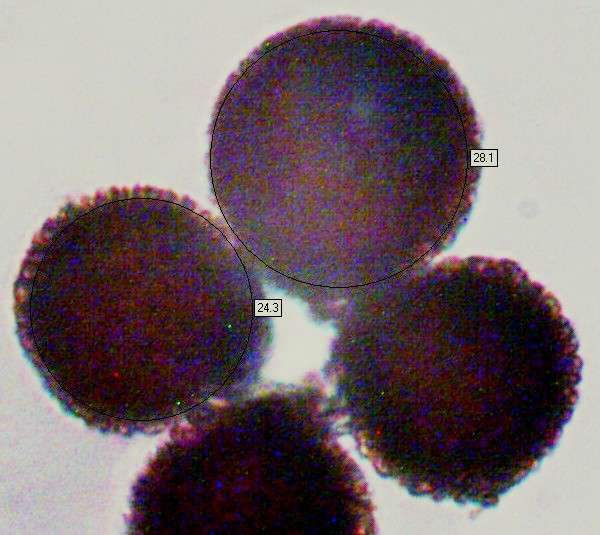Elaphomyces granulatus Fr. - False Truffle
Phylum: Ascomycota - Class: Eurotiomycetes - Order: Eurotiales - Family: Elaphomycetaceae
Distribution - Taxonomic History - Etymology - Identification - Culinary Notes - Reference Sources
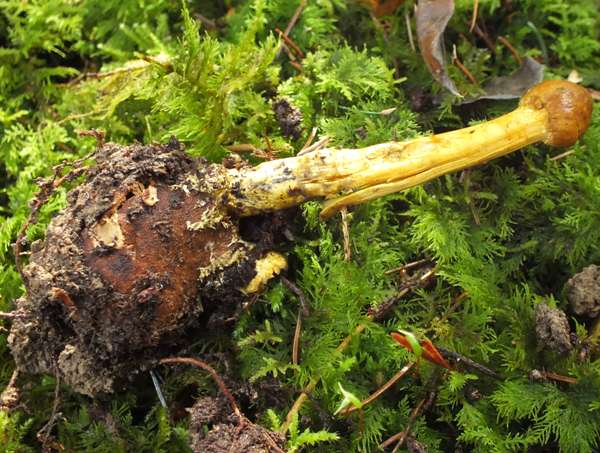
Above: Elaphomyces granulatus (above) parasiticised by club-like Cordyceps capitata
This ascomycete fungus grows in symbiosis with spruce trees, such that tiny mycelial threads from the False Truffle coat the tree’s rootlets to form what are known as mycorrhizas, and the tree and the truffle exchange various chemicals, each thereby assisting the other.
Distribution
The False Truffle is known to occur throughout Europe, including the UK and Ireland where, perhaps because of its lifestyle, it is a rare find.
Being subterranean, these fungi are rarely seen by people walking in woodlands, and so their frequency of occurrence is a matter of conjecture. It is only a minority of people with a real interest in fungi who spend any time poking around among the roots of trees in search of hypogeous (underground) fungi such as truffles the like, but if we all did so a lot more would soon be known about the abundance and distribution of truffles... and maybe a lot more trees would die prematurely during periods of drought, when damage to their root systems must create some additional stress. It you do hunt truffles, it must be a good thing to replace the disturbed soil and to press it down and apply a layer of leaf mulch if any is available nearby. Of course, various animals - wild boar and squirrels in particular - dig up truffles to eat, but their noses are sensitive to the smell of these delicacies and so their excavation is mainly restricted to places where truffles really are; people do lots of nugatory digging.
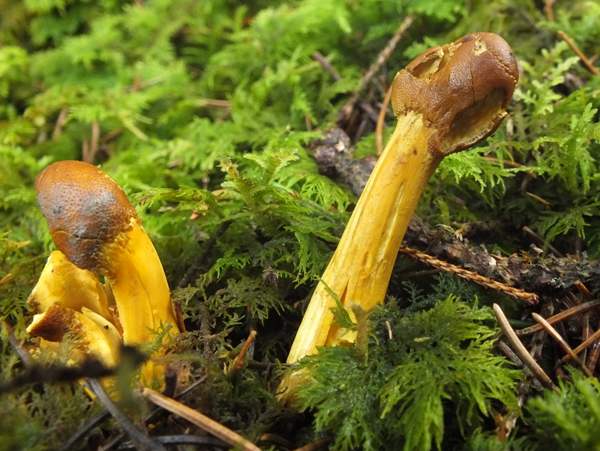
Above: Cordyceps capitata - evidence of False Truffles buried beneath the moss
A foolproof way of finding the False Truffle, Elaphomyces granulatus, is to look for it when it has already been found by the parasitic ascomycete fungus known as the Drumstick Truffleclub. Its scientific name is Cordyceps capitata, and this club fungus just loves eating False Truffles. (It’s true!) What you see sticking up above the ground is a (sterile) yellow stem topped by a shiny brown (fertile) egg-shaped blob. Follow the stem down through the moss of leaf litter until you come to a hard lump... the underground False Truffle, whose mycelium is connected to the rootlets of a nearby conifer (nearly always spruce).
Taxonomic history
When in his Systema mycologicum (1829) the great Swedish mycologist Elias Magnus Fries described the False Truffle he gave it the scientific binomial name Elaphomyces granulatus, and that is still its generally-accepted scientific name.
Etymology
Elaphomyces, the generic name, comes from Elaph-, meaning deer, and -myces meaning fungus (as in mycelium and mycology, for example). Fungi in this genus, and in America Elaphomyces granulatus in particular, are sometimes referred to as 'Deer Truffles' (not to be confused with dear truffles, which is all to do with the price!). The common name Hart's Truffle has also been applied to this species.
Needless to say the specific epithet granulatus relates in some way to a granular characteristic of the False Truffle, and specifically it is a reference to the small granular warts on its outer rind.
Identification guide
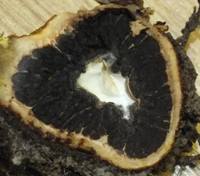 |
FruitbodyIrregularly globose, 2-5cm across; the thick outer skin is rufous brown and covered in small (granular) warts. The interior spore mass is grey and moist initially, drying out and turning purple-black as the spores mature. |
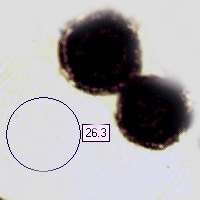 |
SporesGlobose, 25-35μm; ornamented with rods and spines. Spore printPurplish black. |
Habitat & Ecological role |
Ectomycorrhizal, found most often under spruce trees but occasionally with other conifers. |
Season |
False Truffles are slow to rot away and so they can be found throughout the year, although autumn is the best time to look for them because their tell-tale parasite club fungus fruits in the autumn. |
Similar species |
The Périgord Truffle Tuber melanosporum has a blackish surface covered in small crazed polygonal sections with shallow rivers between them; its spore-laden interior is darker than that of the Summer Truffle. The Piedmont White Truffle Tuber magnatum has a pale smooth exterior and a cream or ochre interior. |
Culinary Notes
False Truffles are not edible, although I am sure that an overwhelming majority of squirrels would strongly disagree with this statement. (None of the hypogeous truffle/false truffle fungi is reported to be dangerously poisonous, but in time that situation might well change: many of these species are rarely recorded and so we simply do not know much about them.)
Reference Sources
Fascinated by Fungi, 2nd Edition, Pat O'Reilly 2016, reprinted by Coch-y-bonddu Books in 2022.
Dennis, R.W.G. (1981). British Ascomycetes; Lubrecht & Cramer; ISBN: 3768205525.
Dictionary of the Fungi; Paul M. Kirk, Paul F. Cannon, David W. Minter and J. A. Stalpers; CABI, 2008
Taxonomic history and synonym information on these pages is drawn from many sources but in particular from the British Mycological Society's GB Checklist of Fungi.
Fascinated by Fungi. Back by popular demand, Pat O'Reilly's best-selling 450-page hardback book is available now. The latest second edition was republished with a sparkling new cover design in September 2022 by Coch-y-Bonddu Books. Full details and copies are available from the publisher's online bookshop...
